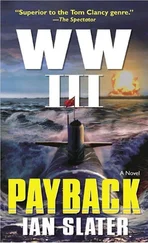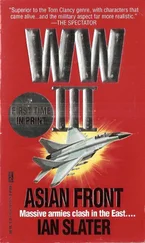Twenty-six-year-old SEAL Peter Dixon, one hand on the grab rail, edged toward the coxswain, asking loudly, “How long?”
“Longer than yours!” yelled the coxswain, grinning in the faint glow of the instrument panel. Dixon’s response: a short, loud obscenity.
“A half hour,” the technician answered.
“My kidneys are rupturing!” put in Rafe Albinski, Dixon’s diving buddy.
“You shouldn’t have any by now!” joshed Dixon, a reference to the thirty-five-year-old Albinski’s long list of gut-jarring missions, one of the most dangerous being during Desert Storm when Albinski, Dixon, and other SEALs, inserted by low silhouette fast boats, had sneaked ashore, planting timer-equipped explosives and assorted machine gun and small arms noisemakers. When these went off, the Iraqis panicked. Believing that the U.S. Marines in the hovercrafts and other vessels offshore were about to land troops, they called for reinforcements—52,000 of them. The SEAL’s colossal feint had thus diverted four Iraqi divisions away from the real Allied offensive.
It had been a tough, exhausting mission, but the truth was, Albinski would have preferred to be on another such covert op than here in the strait. The thirty-foot Bruiser was more than living up to its name, the craft’s lower fiberglass hull and nylon neoprene upper hull taking the kind of punishment en route to Darkstar’s anomaly site unknown to most surface sailors, even to the old-timers of World War II’s Corvette navy, most of them Canadian. They would have recalled the constant battering of the sea against their small ships during the bitter do-or-die Battle of the Atlantic against German U-boats. At sustained periods from thirty to forty miles per hour, the punishment taken by the human body was so severe that more often than not men came back from the high-speed, cold, numbing missions literally bruised black and blue, to say nothing of the long-term effects on their internal organs. Ironically, Dixon and Albinski were relatively warm, the quarter-inch foam beneath their neoprene wet suits having trapped any water entering the suit, their body heat then warming this to create an insulated layer.
Twenty minutes later, as dawn’s light suffused the fog and began burning off the mist, the coxswain turned to the two divers, shouting, “Making good time! Be there in five minutes!” Double-checking his console’s GPS, he told the technician, “Make ready marker buoy,” checked that the RIB’s diving light array was working, and quickly switched it off — all lights working as they should. The next time he turned them on, they’d be on station. Dixon reached forward for his black attack board, the size of a child’s flotation board, only heavier, embedded with a depth gauge, shockproof digital watch and compass, a four-inch-diameter handgrip slot cut on either side of the board. Counting each kick while watching the dials, Dixon and Albinski would be able to estimate how far they were going on their search pattern of the anomaly grid. As Dixon grabbed for the board, the Bruiser was punched hard midships in a cross swell, flinging him against the grab rail, the attack board clattering onto the platform.
“That’ll help it,” said Albinski wryly.
Abruptly, the motors died to slow/idle, the RIB’s diving lights on.
“After all this,” said Dixon, adjusting his face mask, “I hope we find something.”
The RIB technician was busy helping the divers with their tanks, weight belts, and the rest, and the coxswain maneuvered the boat to provide as stable a platform as possible against the incoming tide. But once the divers were over, he knew there’d be nothing to do but sit. And wait. For the mechanic, the pitch and yaw of the boat by the marker buoy on station was much more likely to make him feel queasy than the bruising run out from Port Angeles.
In the next minute both divers checked their flashlights and spat on the inside of their face masks, rubbing the spittle about as a condensation preventative, ready to go over the starboard side. Dixon would lead with the attack board.
The crew of the Utah were no longer on battle stations, a sonar man having mistaken the sound of a Canadian sub — indeed, the only sub the Canadians had on their west coast — as that of a possible hostile. Alicia had returned to the wardroom, working on the torpedoes’ telemetry data, when Rorke reentered and poured himself a coffee. “Hope we didn’t frighten you with that latest alert?”
“I wasn’t frightened.”
He seemed not to hear, continuing, “Repairs to the sub’s diving planes changed the Canadians’ sound signature as it egressed from Esquimalt. That’s Vancouver Island’s southeastern harbor.”
She knew where it was. It was a big Canadian naval base, full of obsolete warships. “Shouldn’t that have been in your listening mike SOSUS computers?” she asked. “I mean, shouldn’t the microphones have picked up the sub’s new signature?”
“Murphy’s Law,” he answered.
“On the most sophisticated WP in the world?” she countered with mock severity, her use of WP for “weapons platform” telling him she knew more than he might think.
“Yes,” he answered quietly, defensively. It was the first time Alicia had seen Utah ’s captain look anything like sheepish as he added, “Canucks should have notified us.”
“Perhaps they did?” Why was she doing this? she asked herself, her tone with him becoming almost accusatory when what she really wanted to do was endear herself to him. Was it her professional curiosity overriding her amorous intent? Or was it some latent feminist aggressive streak in her that had driven her to the top of her field in a world still overwhelmingly dominated by men? But she didn’t like feminists. In her opinion, they were pushy and shrill.
“Perhaps they did notify us,” Rorke conceded. “Anyway,” he added tersely, “I’m responsible.”
Oh damn, she thought, no he’s not. But he was adopting the Navy’s time-honored stance that whoever was in command was responsible. If a seaquake, which happened often enough near the Juan de Fuca plate, swallowed up his sub, he would still be held responsible as far as the Navy was concerned.
“I’m sorry,” Alicia said hastily. “I didn’t mean to imply—”
“Captain!” It was the officer of the deck, Ray Peel, on the speaker. “Bogey on screen.”
“Coming,” Rorke replied, striding out of the wardroom.
Now she’d missed the opportunity to apologize, she realized. What had begun as a simple tease had ended in an absolute muddle, precisely the opposite of what she’d intended. She knew a lot about telemetry, but men?
“What’s your best guess, gentlemen?” Rorke asked his sonar operators, each one working the scores of vertical lines on his green “waterfall” screen, each wiggle representing a different sound from the cacophony in what most people erroneously imagined was a silent underworld. “Whales?” Rorke suggested. “Shrimp? Distant volcanic—”
“Definitely not a sub,” the senior sonar man replied, the others readily agreeing. “It’s very weak, sir. But it’s there.”
“Distant Ivan?” Rorke pressed, meaning the noise might be the remnants of a faraway active pulse from a Russian sub.
“No, sir. Not a sub. No way.”
“Very well,” said Rorke, his eyes scanning the arc of green falls to his right. “Keep tracking it. Officer of the deck, no change of watch for sonar men while we’re on this.”
“No change of watch, aye, sir,” Ray Peel acknowledged.
The two divers fell back in unison, the cold, backward plunge hitting Dixon’s forehead with the force of an ice cream headache in high summer, startling his senses into high alert. Rafe Albinski’s reaction was more sanguine. Long experience plus his naturally more relaxed nature allowed him to absorb the facial shock as little more than one experienced during a dramatic change of temperature while taking a shower. It was something which happened to him frequently whenever his seventeen-year-old son, Dirk, against house rules, turned on the hot water tap in his basement shower, momentarily freezing Rafe in the upstairs shower, where Rafe would thump the wall. “Goddammit, Dirk!” Albinski smiled when he thought of Dirk. They were close — except when he turned on the basement tap.
Читать дальше












